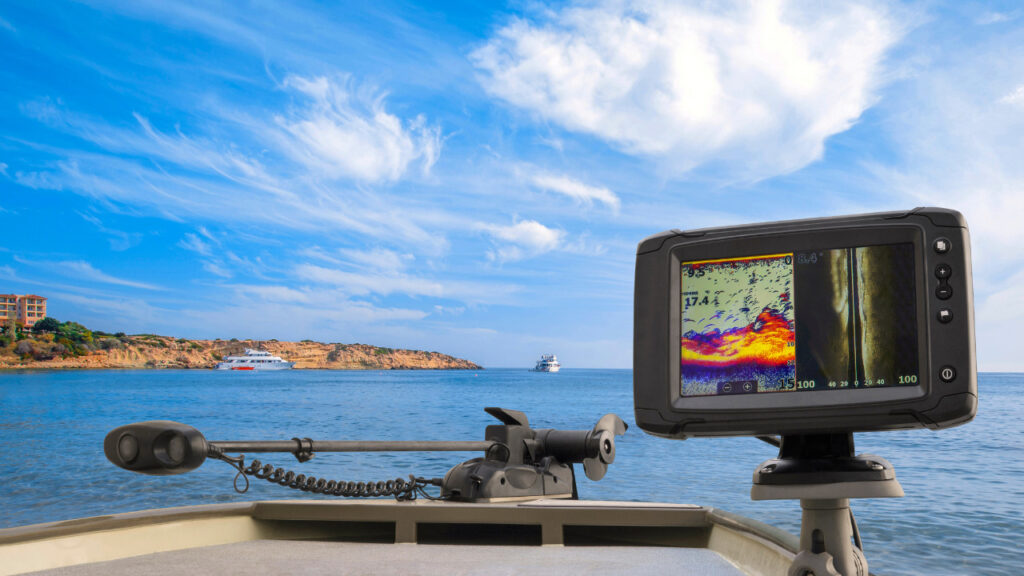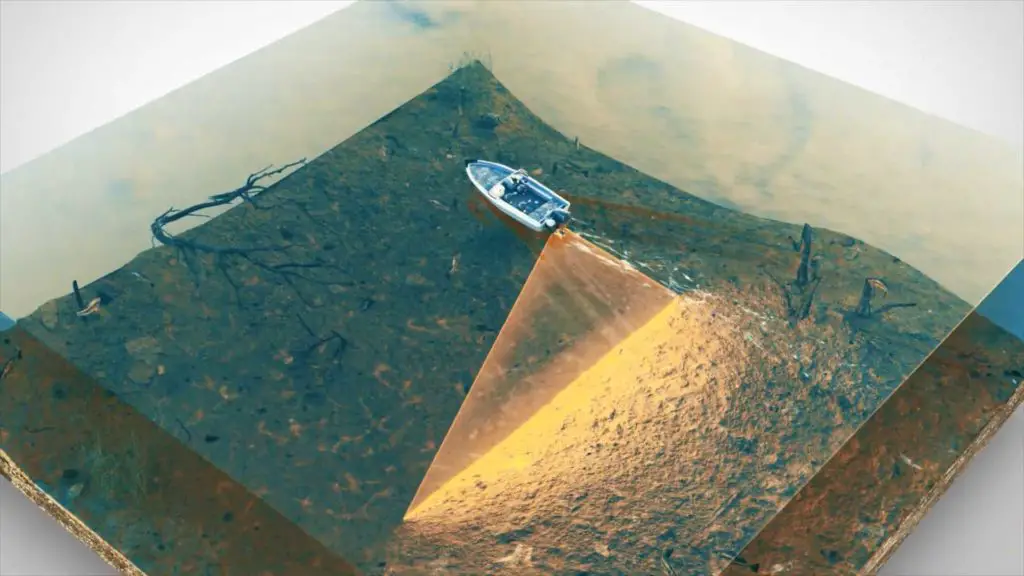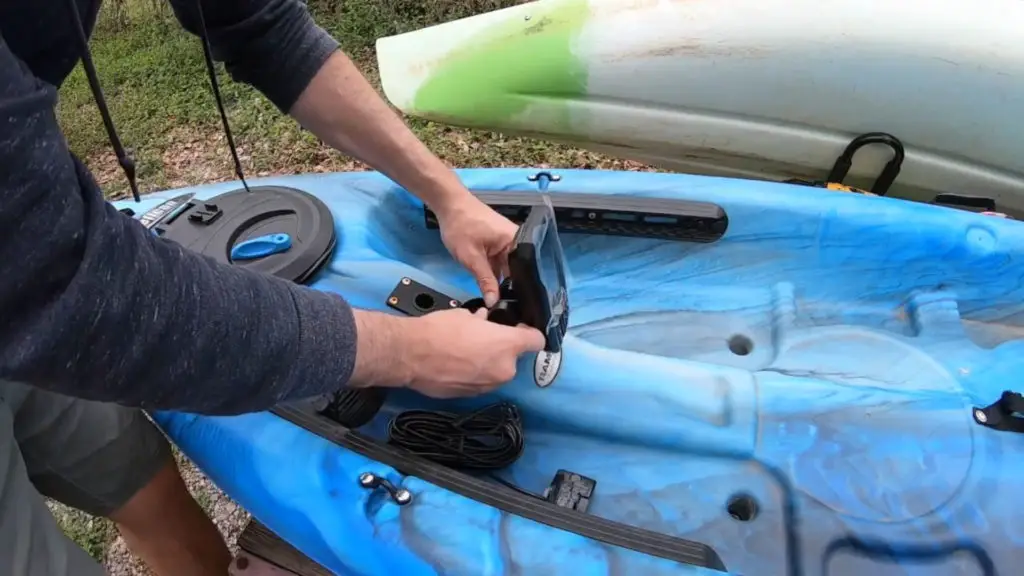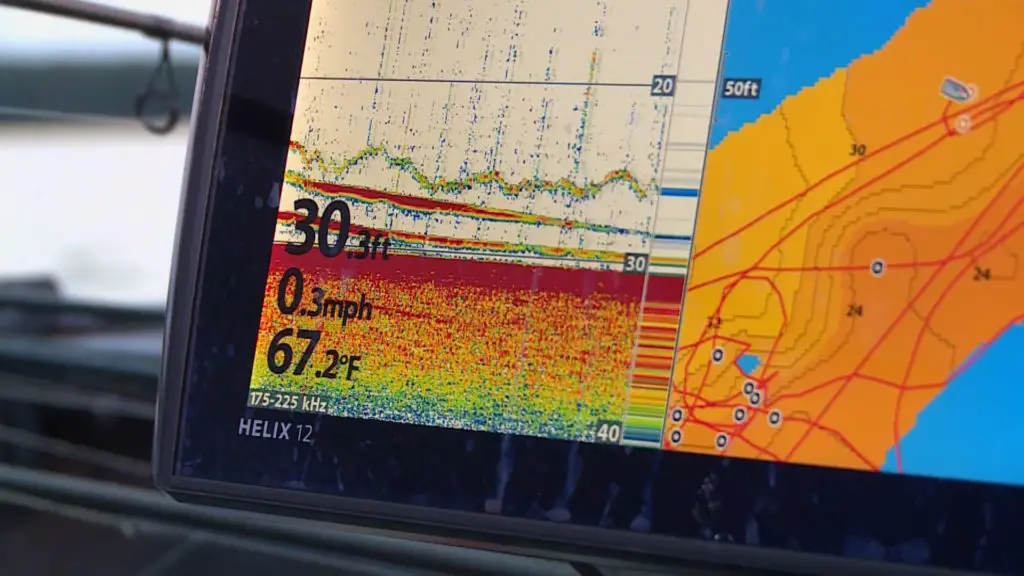
Fish Finders work perfectly in shallow water, provided the sonar frequency is high enough. The recommended frequency to use in shallow water should be in the ranges of 200kHz, 455kHz, and 800kHz.
This is because a higher frequency will guarantee more accurate results and enable the angler to determine the exact location of the fish. Furthermore, a high frequency enhances the resolution of the display screen, minimizing the chances of misreading.
The success of using fish finders to catch fish in shallow waters is mostly dependant on your skill as a fisherman.
You should know how to use and interpret the signals provided by the fish finder and apply your fishing skills to catch the fish. Therefore, it is vital first to understand how a fish finder works.
Table of Contents
How Does A Fish Finder Work?
Fish finders are devices that use sonar technology to identify and locate fish underwater. The device has a monitor that displays the signals collected by the fish finder. These signals guide the angler to where the fish are located.
Fish finders are made up of two main parts- the main processor and the transducer. The transducer has piezoelectric signals that send sonar pulses into the water at a certain vibration frequency.

Once the pulses hit an object, say, a fish, they are echoed back to the transducer, which then picks up the signals.
These signals are then passed over to the processor for translation and, thereafter, displayed on the screen as information.
The information provided by a fish finder includes the depth of the water, its temperature, bottom consistency, and in the more modern devices, the GPS coordinates.
How To Use A Fish Finder In Shallow Water
It is vital to know how to apply the full potential of a fish finder before you set out sailing. Being in the know will enable you to tap into your adventurous spirit as you try different things that the fish finder can do.
The first thing you should know about using a fish finder in shallow water is choosing the suitable model and the best battery.
The type of battery mainly depends on the power you require, and the model depends on the fishing technique. Essentially, you would require a basic model with a high frequency, hence, a high-power battery.

Next, you should know how to set up your fish finder for it to perform optimally. Installing a high-frequency fish finder on a boat or a kayak is extremely easy.
The only thing you would be required to do is place the battery inside a waterproof box just in case water flows into the boat.
Most importantly, you should be able to read and interpret sonar signals on the shallow water fish finder device.
The general rule of reading the sonar is: curves represent animate objects, and flat lines represent inanimate objects. This simple rule will guide you on when to pull out your fishing rod.
What Are The Key Features Of Fish Finders For Shallow Water?
Your fish finder has to have the following features if you are planning on fishing in shallow water:
- High Frequency
A fish finder that will work effectively in shallow water should have a relatively high frequency, ranging from upwards of 200kHz. A high frequency provides more accurate results that enable the angler to find the fish faster.
- Good Display Screen Resolution
A high screen resolution will provide you with more accurate details. The more detailed it is, the higher the chances for you to determine the size of the fish and even have an idea as to what species of fish it is.

This will make your experience fishing in shallow water a breeze. For instance, you will not waste your time going after a fish species other than which you had planned to catch.
Remember that the resolution of the display screen is positively proportional to the frequency- this means that a high frequency will result in a high screen resolution.
- Side Imaging Radar
Side imaging is a relatively new technology found in fish finders that fall within the 455kHz to 800kHz frequency ranges. Usually, fish finders with high frequencies cover very compact surface areas- the side imaging radar makes up for this.
The side imaging radar shoots at a sideways angle on both sides of your fishing vessel, providing you with a broader range of view. That is not all; it also gives you a 3D perspective that offers more detail for an angler to make a better judgment.
Why Your Fish Finder Is Not Performing Optimally in Shallow Water
Sometimes your fish finder might not give you the best results due to one of the following reasons.
- The model is not suitable – It is important to note that the types of fish finders used in shallow water are different from those used in deep-sea or lake fishing. Shallow water requires models with high frequencies – anything short will not provide you with accurate readings.
- The quality is off- With the number of products available in the market, it is very easy to buy low-quality ones. It could be that the device was on sale or the cheapest in the store. You should never compromise on quality just to save money. If you want to get a fish finder that makes fishing easy, you should be willing to spend an equivalent amount of money.
- It has seen better days– It is not every time that old is gold. In the case of fish finders, the older it is, the less dependable it becomes. Like other technological devices such as smartphones, fish finders should be updated and replaced every few years.
- The configuration is wrong– A lot of people operate on default settings of the fish finder, limiting the device’s ability in situations that require specific settings. These settings may include sensitivity adjustments, different colors, and transducer selection. When these values are incorrect, the finder will not display accurate signals.
- Lack of knowledge on how to use it– If you don’t know how to operate your transducer, there is no way you will get the best out of it. You need to learn your device before you can derive maximum utility from it.
Our Fish Finder choice for shallow water
- FISHREVEAL: Fish are easier to find and easier to identify. FishReveal combines the target separation of Lowrance CHIRP sonar and the high-resolution images of structure from DownScan Imaging to makes fish light up on your display.
Final Words
Fish finders work well in shallow waters, provided the frequency is upwards of 200kHz. A high frequency leads to increased screen resolution and more accurate results. This makes fishing in shallow water easy and convenient.
It is crucial to choose the perfect fish finder for fishing in shallow water. More importantly, you should make sure that the configuration and installation are done correctly.
Remember that you will not get the most out of your fish finder if you don’t understand how it works.